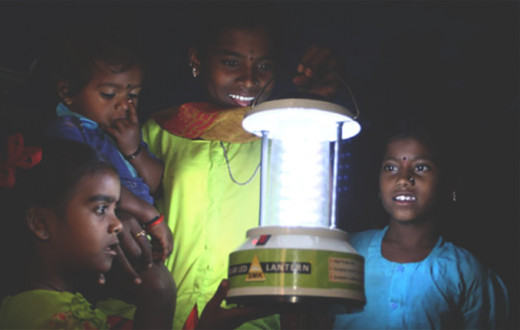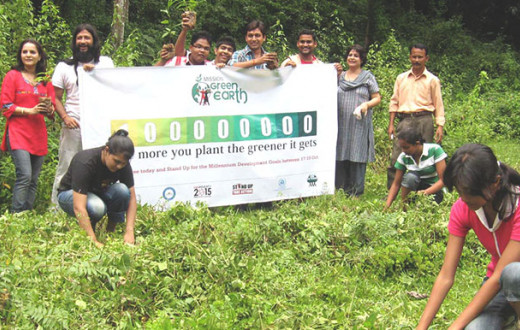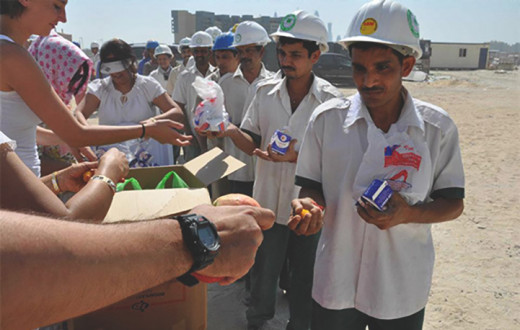SANDEEP It’s 5 in the morning in Amjhor, a village situated in the heart of a naxal belt in Jharkhand. A little girl and her brother wake up, looking forward to another day. They brush their teeth and go for a bath, the whole time humming a ‘bhajan’ they learnt in school. Carefully oiling their hair, the mother is happy to send them off to school. Dressed in white uniforms with good shoes that will last them the whole year, the brother and sister leave for school. It’s a five kilometer walk through the village and the jungle, which they take every day. Passing the empty government school in which they used to study till a few months ago, they greet Sandeep and me with a ‘Jai Gurudev’ as we passed them smiling and yelling a ‘Jai Gurudev’ too. I reached the school before the little brother and sister, I was on a bike.
The school, ‘Sri Sri Gyan Mandir’ is an open space in the interiors of Patamda in a tribal village called Jajradih. The school has three classrooms. One, which is a long tin shed under which the little kids (1st to 5th) sit and study, and the other two are two big tamarind trees, under who’s cool shade the big kids (6th and 7th) sit and study. When I reached, I only saw nicely packed bags sitting under the shade, the kids had assembled in the middle of the space and were saying their morning prayers, “itni shakti humein de oh daataa, mann ka vishwas kamzor ho na,” (god, give us strength so that the faith in us doesn’t get weak). It was beautiful to see around 150 little kids with folded hands and closed eyes singing this prayer rising to a crescendo. Like the two little brother and sister, there are many such kids that walk down to this school from neighboring villages every morning.
This is in stark contrast to the picture of children in unclean clothes, playing with goats and marbles, whiling away their time, or even worse, playing with guns and learning to make small bombs – not an un-common sight in such remote naxal areas.
During my stay in the Patamda Ashram, Jharkhand, I had the opportunity to understand the education given to the children in other goverment schools, and there was none to understand. The children simply didn’t go to the schools! Yes, the government has constructed ‘pucca’ classrooms, but does infrastructure alone guarantee education? What is the point of classrooms and benches and desks if there are no students? And the teachers are themselves stressed and not particularly motivated to give any value education. So, why aren’t the children going to these schools? It is because the experience they have on a school day is pathetic.
Education is life changing. Life changing education doesn’t happen only through a teacher’s words or reading out a text book, or a chalk filling the blackboard. Life changing education has to be given from the heart. Life changing education not only nourishes the intellect, it should also nourish the spirit, it should build a child’s character and shape him or her for the future. Life changing education has to be holistic. And that is what is missing in the local schools in these remote Indian terrains.
It is challenging to create such an atmosphere of love and inspiration for children amidst so much fear and violence. This is where spirituality helps. Violence cannot be tackled by more violence. The seeds of peace have to be sown in the young hearts and minds of these villages through value-based holistic education to ensure that the future is one of progress and harmony and not of fear and frustration. It is impossible to free oneself of the kind of stresses that build up living in such conditions without the help of powerful spiritual techniques. Here, Sudarshan Kriya and meditation play a very vital role.
‘Sri Sri Gyan Mandir’ in Jajradih, Patamda, is one of the 425 rural schools that give holistic education to children. It has been two years since the school has started. The villagers and the volunteers have helped level the land. They contributed and have dug a bore-well for water. The school is far from being complete, proper classrooms are in the pipeline. Things are not that easy to manifest in such remote areas, especially without the help of the government and such bodies, and yet ironically, the paperwork has to go through them. The five full time teachers and the many part time Yuvacharyas impart value based education to these little kids who don’t even care for infrastructure. Many of these children come from a violent environment, naxalism, family feuds, drunk and violent parents; these kids find solace in these schools run by The Art of Living. The same kids who were hardly going to school previously, come here every day, without fail, sit under the open sky and learn. Besides the free uniforms, shoes, books and lunch, what they receive here is holistic education, that too from teachers who are on the spiritual path. Music, meditation, dance, chanting, and games add perfectly to the academic studies that these children receive. They love coming here every day, so much that they refuse to stay at home during holidays. Are they bribed? Forced? Or threatened to come to school? No, they are taken care of and loved individually. They are educated in social responsibility, hygiene, health and human values along with their regular curriculum. The strong impressions of violence and fear are cleansed from their young minds through the spiritual practices and they feel light, fresh and free. As a result the children ‘want’ to learn and they ‘want’ to come to school. And that is the difference between just education and holistic education. These children are certainly rays of hope for our nation that has almost forgotten about them. This is how education should be, shouldn’t it?
If you like the story please write to us at webteam.india@artofliving.org.
Writer: Eben Felix, Graphics: Niladri Dutta








